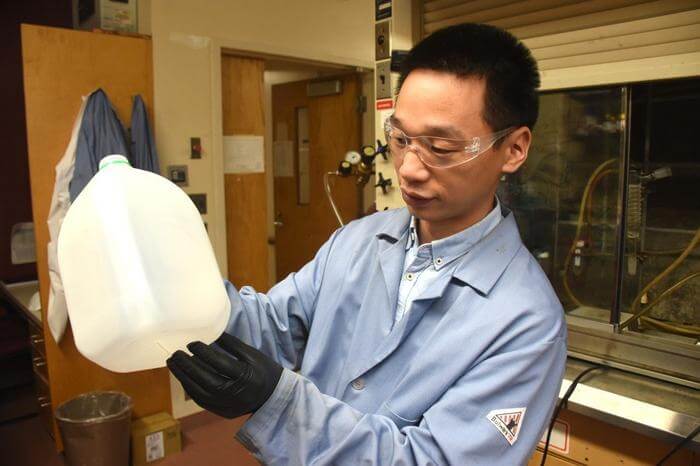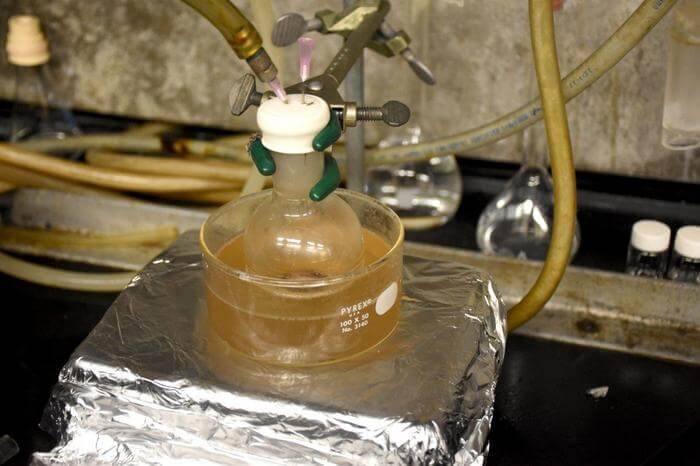BLACKSBURG, Va. — Genius moments can happen anywhere at any time. For a scientist from Virginia Tech, a night by the fireplace has led to the creation of a recycling method that turns plastic waste into soap! This discovery could allow society to take the growing problem of plastic pollution and recycle everyday garbage — including milk cartons, food containers, and shopping bags — into useful cleaning products.
A team of scientists at Virginia Tech College of Science developed this innovative technique for upcycling plastics into high-value chemicals known as surfactants, which are commonly used in soap and detergents. They hope this will provide a cost-effective way to significantly reduce the escalating levels of plastic pollution worldwide.
At first glance, plastics and soaps seem to have little in common in terms of texture, appearance, and usage. However, the research team identified a surprising molecular connection between the two. The chemical structure of polyethylene, one of the most widely used plastics in the world, is strikingly similar to that of fatty acids, which are precursors to soap. Both materials are composed of long carbon chains, but fatty acids have an additional group of atoms at the chain’s end.
Professor Guoliang “Greg” Liu theorized that this similarity suggested the possibility of converting polyethylene into fatty acids. With some modifications to the process, scientists could then produce soap.

This idea struck him during a winter evening by the fireplace, where he observed the rising smoke from the fire, comprising tiny particles produced during wood combustion. Although plastics should never be burned in a fireplace due to safety and environmental concerns, Prof. Liu began to ponder the idea of burning polyethylene safely in a laboratory setting.
“Firewood is mostly made of polymers such as cellulose. The combustion of firewood breaks these polymers into short chains, and then into small gaseous molecules before full oxidation to carbon dioxide,” says Liu, the holder of the Blackwood Junior Faculty Fellowship of Life Sciences in the Department of Chemistry, in a media release. “If we similarly break down the synthetic polyethylene molecules but stop the process before they break all the way down to small gaseous molecules, then we should obtain short-chain, polyethylene-like molecules.”
To test this, Prof. Liu constructed a small oven-like reactor where the team could heat polyethylene in a process known as temperature-gradient thermolysis. Within the oven, the temperature at the bottom was hot enough to break the polymer chains, while the top was cool enough to halt any further breakdown.
After thermolysis, the team collected the residue, similar to cleaning soot from a chimney, and found that Prof. Liu’s hunch was correct. It consisted of “short-chain polyethylene,” or more precisely, waxes.
This was the first step towards developing a method for upcycling plastics into soap. After adding more steps, including saponification, the team succeeded in creating the world’s first soap made from plastics.
To refine the process, they collaborated with experts in computer modeling, economic analysis, and other areas. Their groundbreaking work was subsequently published in the journal Science.

“Our research demonstrates a new route for plastic upcycling without using novel catalysts or complex procedures. In this work, we have shown the potential of a tandem strategy for plastic recycling,” says lead study author Zhen Xu, a PhD chemistry student in Prof. Liu’s lab. “This will enlighten people to develop more creative designs of upcycling procedures in the future.”
Though polyethylene inspired the project, the team states that the upcycling method could also work with another common plastic, polypropylene. These two materials constitute much of the everyday plastic we encounter, including product packaging, food containers, and fabrics. Prof. Liu’s upcycling method can be applied to both types simultaneously, eliminating the need for separation and thereby offering an advantage over some current recycling methods.
A further benefit of the technique is its simplicity, requiring only plastic and heat. Additionally, while soap may not seem like an expensive commodity, it can actually be worth two or three times more than plastics when compared by weight.
Prof. Liu believes this study paves the way for reducing waste by diverting used plastics into the production of valuable materials. He is optimistic that recycling facilities worldwide will eventually adopt this technique, leading to the availability of revolutionary sustainable soap products that could also reduce plastic waste in landfills.
“It should be realized that plastic pollution is a global challenge rather than a problem of a few mainstream countries. Compared to a sophisticated process and complex catalyst or reagent, a simple process may be more accessible to many other countries worldwide,” Xu concludes. “I hope this can be a good start for the war fighting plastic pollution.”
South West News Service writer Stephen Beech contributed to this report.


Yes, but will it impoverish people and make them more dependent on government? That’s what’s needed to make it acceptable.